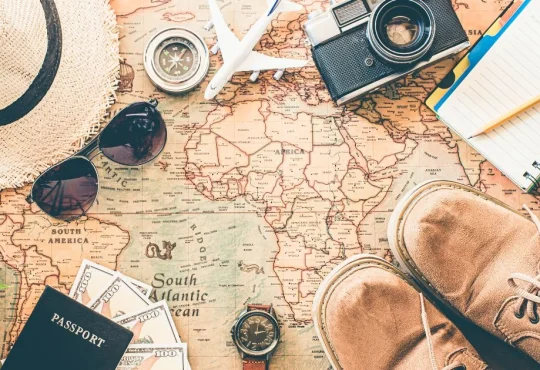In recent years, the world has seen an explosion in tourism, with millions of travelers seeking to explore every corner of the globe. While the allure of new destinations is undeniable, this surge in travel has also brought with it a darker side: overtourism. From environmental degradation to cultural erosion, the impact of overtourism is becoming impossible to ignore. This blog post isn’t about discouraging travel altogether—far from it. Instead, it’s a call to action for more mindful exploration. Plan your travels wisely with our guide to the top countries to avoid in 2025 and discover how responsible tourism can support sustainable destinations.
Perennial No-Go Destinations
1. Bali, Indonesia: A Paradise Under Siege
The growing menace of plastic waste increasingly mars Bali‘s stunning reputation as a tropical paradise. Garbage has now littered beaches that once boasted crystal-clear waters, much of it washed ashore from both local sources and international waters. Despite significant clean-up efforts and awareness campaigns, the sheer volume of waste continues to rise. This pollution threatens the island’s tourism industry and marine life, as countless species face dangers from ingesting or becoming entangled in plastic debris. With urgent and sustained intervention, Bali can maintain its status as one of the world’s top island destinations.
Bali’s rich Hindu heritage and traditional way of life are under siege from the pressures of mass tourism. Sacred ceremonies and community rituals often need more support as eager tourists intrude with cameras and little understanding of local customs. The island’s iconic temples, such as Tanah Lot and Uluwatu, are increasingly seen as photo ops rather than spiritual spaces. While tourism provides livelihoods for many Balinese families, it has also brought rapid commercialization, diluting the island’s authentic charm. Protecting Bali’s culture from these external pressures is as critical as addressing its environmental issues.
2. European Hotspots: Barcelona, Venice, and Beyond
The glittering allure of cities like Barcelona and Venice belies the growing discontent among their residents. In Barcelona, locals have taken to the streets, protesting against noise, overcrowding, and housing inflation caused by the rise of short-term rentals. Similarly, Venice’s residents face daily challenges, from crowded waterbuses to an overwhelming number of day-trippers flooding the city’s narrow streets. Efforts to introduce tourist taxes and restrict accommodation options have met mixed reactions, reflecting the tension between economic reliance on tourism and the quality of life for locals. As protests continue, these cities symbolize the need for sustainable tourism practices that benefit residents and visitors.
The breathtaking beauty of Venice’s canals and Barcelona’s Gothic Quarter hides a troubling reality: the strain of mass tourism is taking a toll on historic infrastructure. In Venice, the constant flow of cruise ships has caused erosion of the fragile lagoon, while overcrowding threatens the structural integrity of iconic landmarks. Barcelona faces similar challenges, with its streets and public spaces overwhelmed by tourists, leaving little room for locals to navigate their daily lives. The influx of visitors has also led to the deterioration of public services, from waste management to transportation systems. Addressing these issues is vital to preserving these iconic destinations’ cultural and architectural heritage.
3. Koh Samui, Thailand: A Troubled Paradise
Following the immense popularity of HBO’s The White Lotus, Koh Samui is bracing for a surge in tourism. While the show’s picturesque depiction of island life may boost visitor numbers, it also raises concerns about the island’s ability to handle increased demand. Already a favorite for luxury travelers, Koh Samui faces the risk of becoming overcrowded, straining its hospitality infrastructure. Famous beaches and attractions will likely see a sharp rise in footfall, potentially detracting from their natural allure. This trend underscores the need for careful planning to balance Koh Samui’s newfound fame with sustainable growth.
The rapid pace of development on Koh Samui is threatening the island’s fragile ecosystems. Developers are clearing mangroves and forests to make way for resorts and villas, and waste management systems need improvement to handle growing volumes of garbage. The diversion of local resources to meet the demands of tourists is often at the expense of local needs. Additionally, coral reefs around the island deteriorate due to increased boat traffic and unregulated snorkeling activities. Koh Samui risks becoming a cautionary tale of how unchecked tourism can damage a destination without proactive measures.
Destinations on the Verge
While some locations are already buckling under the strain of over-tourism, others are on the brink of crisis. Here are a few destinations that could suffer similar fates if current trends continue:
4. Agrigento, Italy: Water Scarcity Looms
The historic city of Agrigento, home to the famous Valley of the Temples, is grappling with a severe water shortage. As tourism numbers increase, so does the strain on the city’s already limited water resources, threatening the daily lives of locals and visitors’ experience. The growing pressure on the city’s infrastructure is an increasing concern, as essential utilities like water may become even more challenging to secure. The local economy heavily relies on tourism, but sustainable resource management is necessary for residents and tourists to feel the consequences. Immediate action is essential to address the region’s environmental challenges, which could otherwise threaten the future of tourism in Agrigento.
5. British Virgin Islands: Cruise Ship Concerns
The British Virgin Islands have become a favored destination for cruise ships, drawing thousands of visitors daily. However, this surge in short-term visitors brings a range of issues, from overcrowded ports to the strain on local infrastructure. Despite the influx of tourists, the economic benefits of cruise tourism are limited because much of the spending flows to large corporations rather than local businesses. The environmental impact of these massive vessels also cannot be ignored, as they contribute to pollution and the destruction of marine ecosystems. As the islands increasingly rely on this type of tourism, the industry’s long-term sustainability comes into question.
6. Kerala, India: Crowding the Backwaters
Kerala’s backwaters, once known for their serene beauty and tranquility, are increasingly overcrowded with houseboats and tourists. As the popularity of this destination grows, the peaceful atmosphere that once defined the backwaters is rapidly disappearing, replaced by noisy, motorized boats and crowds of visitors. This issue of ever-increasing traffic disrupts the calm environment and damages the fragile ecosystems that make Kerala’s backwaters so unique. Pollution levels are rising, and this unsustainable tourism threatens the delicate balance of local flora and fauna. With proper management, Kerala’s backwaters can retain the qualities that initially made it a top destination.
7. Kyoto and Tokyo, Japan: The Challenges of Popularity
Japan’s rich cultural heritage attracts millions of tourists yearly, but this influx has challenges. In Kyoto, visitors’ lack of understanding of local customs has led to frustration among locals, with incidents of tourists trespassing into private gardens or disrupting traditional ceremonies. This cultural insensitivity diminishes the experiences that make Kyoto unique and meaningful. The city’s historical landmarks, including temples and shrines, are seeing a rise in overcrowding, making it difficult for tourists to appreciate their beauty and significance fully. Tourism is crucial to the local economy, but it’s evident that greater awareness is needed to maintain the delicate balance between welcoming visitors and preserving cultural integrity.
Tokyo, a bustling metropolis, faces its problems as it grapples with the strain of mass tourism. Overcrowding in popular tourist areas such as Shibuya and Asakusa is especially problematic during peak travel, leading to long lines, traffic congestion, and diminished tourist experiences. The city’s extensive public transportation system, known for its efficiency, becomes overwhelmed by the sheer number of commuters and tourists, resulting in delays and discomfort for everyone. Hotel accommodations, too, are often fully booked, forcing tourists to look for options far outside the city center, impacting both convenience and affordability. Tokyo’s role as a global hub requires careful management to avoid negatively affecting the quality of life for residents and visitors alike.
8. Oaxaca, Mexico: A City Under Pressure
Tourism in Oaxaca has skyrocketed in recent years, but this growth has come with significant consequences. One of the most visible impacts has been the rising cost of living, making it increasingly difficult for locals to afford housing and necessities. The once vibrant, local-driven markets are now replaced by shops catering primarily to tourists, pushing traditional businesses out. The influx of wealthier visitors has increased prices, making Oaxaca less accessible to its residents and altering its authentic charm. As the cost of living continues to climb, many locals are forced to leave the city, potentially losing the cultural richness that has made it special.
The rapid increase in tourism has also placed a heavy burden on Oaxaca’s infrastructure. With the increasing number of visitors, roads, public transportation, and waste management systems are struggling to keep up, resulting in overcrowded streets and inefficient services. The city’s limited resources, which never accounted for such large crowds, compound these logistical challenges. Local governments are struggling to balance the demands of tourism and the needs of permanent residents. Failure to address these issues risks allowing Oaxaca’s growing pains to overshadow its traditional character and appeal.
9. Scotland’s Route 66, North Coast 500: The Hidden Costs of Scenic Drives
Dubbed “Scotland’s Route 66,” the North Coast 500 is a dream come true for road trip enthusiasts seeking stunning views and rugged landscapes. However, its rising popularity has led to severe traffic congestion, especially during the summer when the route sees the most visitors. This influx of cars has created problems for local communities, as narrow roads become clogged, making it harder for residents to carry out daily activities. The increase in traffic also diminishes the road trip experience for tourists, as they encounter longer delays and reduced access to key sights. As the route grows in popularity, it becomes increasingly more work to maintain the idyllic charm that initially drew visitors to the area.
The environmental impact of the increased traffic on the North Coast 500 is also a growing concern. The region’s fragile ecosystems are threatened by the littering, trampling of vegetation, and noise pollution caused by the surge in tourists. Popular viewpoints and natural areas have seen significant wear and tear, while wildlife habitats are disturbed by the constant stream of visitors. Additionally, the region’s infrastructure, such as waste management and rest areas, needs help to cope with the rising number of tourists. Without sustainable tourism management, the beauty of Scotland’s North Coast risks facing irreversible damage.
How You Can Help: Responsible Travel Tips
The good news? There’s still hope. Making thoughtful choices contributes significantly to a more sustainable future for tourism. Here are some valuable tips to help you get started:
- Choose Off-Peak Travel Times: Visiting during less crowded seasons can ease the strain on popular destinations while offering a more authentic experience.
- Support Local Businesses: Choose locally owned accommodations, restaurants, and tour operators to ensure your spending benefits the community directly.
- Respect Local Customs: Learn about the traditions and etiquette of the places you visit, and try to honor them.
- Limit Single-Use Plastics: Bring a reusable water bottle, straw, and bag to reduce travel waste.
- Stay Longer, Travel Slower: Instead of rushing through multiple destinations, spend more time in fewer places to reduce your environmental footprint and genuinely connect with the local culture.





